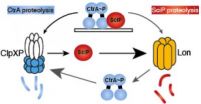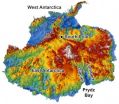(Press-News.org) BETHESDA, MD – March 5, 2013 -- A team of European scientists from the University Medical Center Hamburg-Eppendorf (UKE) and the Cologne Excellence Cluster on Cellular Stress Responses in Aging-Associated Diseases (CECAD) at the University of Cologne in Germany has taken an important step closer to understanding the root cause of age-related dementia. In research involving both worms and mice, they have found that age-related dementia is likely the result of a declining ability of neurons to dispose of unwanted aggregated proteins. As protein disposal becomes significantly less efficient with increasing age, the buildup of these unwanted proteins ultimately leads to the development and progression of dementia. This research appears in the March 2013 issue of the journal Genetics (http://www.genetics.org).
"By studying disease progression in dementia, specifically by focusing on mechanisms neurons use to dispose of unwanted proteins, we show how these are interconnected and how these mechanisms deteriorate over time," said Markus Glatzel, M.D., a researcher involved in the work from the Institute of Neuropathology at UKE in Hamburg, Germany. "This gives us a better understanding as to why dementias affect older persons; the ultimate aim is to use these insights to devise novel therapies to restore the full capacity of protein disposal in aged neurons."
To make this discovery, scientists carried out their experiments in both worm and mouse models that had a genetically-determined dementia in which the disease was caused by protein accumulation in neurons. In the worm model, researchers in the lab of Thorsten Hoppe, Ph.D., from the CECAD Cluster of Excellence could inactivate distinct routes used for the disposal of the unwanted proteins. Results provided valuable insight into the mechanisms that neurons use to cope with protein accumulation. These pathways were then assessed in young and aged mice. This study provides an explanation of why dementias exponentially increase with age. Additionally, neuron protein disposal methods may offer a therapeutic target for the development of drugs to treat and/or prevent dementias.
"This is an exciting study that helps us understand what's going wrong at a cellular level in age-related dementias," said Mark Johnston, Ph.D., Editor-in-Chief of the journal Genetics. "This research holds possibilities for future identification of substances that can prevent, stop, or reverse this cellular malfunction in humans."
INFORMATION:
CITATION: Schipanski, Angela, Sascha Lange, Alexandra Segref, Aljona Gutschmidt, David A. Lomas, Elena Miranda, Michaela Schweizer, Thorsten Hoppe, and Markus Glatzel
A Novel Interaction between Aging and ER Overload in a Protein Conformational Dementia
Genetics March 2013, 193: 865-876.
FUNDING: This work is supported by grants of the Deutsche Forschungsgemeinschaft (especially the FOR885 to M.G. and T.H., the Cologne Excellence Cluster on Cellular Stress Responses in Aging-Associated Diseases (CECAD) to T.H. and GRK1459 to M.G.), the Medical Research Council (UK) to D.L., the Hans und Ilse Breuer Foundation to S.L., the Leibniz Center Infection Graduate School (Model systems for infectious diseases), and the Landesexzellenzinitiative of Hamburg (SDI-LEXI) to M.G.
ABOUT GENETICS: Since 1916, Genetics (http://www.genetics.org/) has covered high quality, original research on a range of topics bearing on inheritance, including population and evolutionary genetics, complex traits, developmental and behavioral genetics, cellular genetics, gene expression, genome integrity and transmission, and genome and systems biology. Genetics, a peer-reviewed, peer-edited journal of the Genetics Society of America is one of the world's most cited journals in genetics and heredity.
ABOUT GSA: Founded in 1931, the Genetics Society of America (GSA) is the professional membership organization for scientific researchers, educators, bioengineers, bioinformaticians and others interested in the field of genetics. Its nearly 5,000 members work to advance knowledge in the basic mechanisms of inheritance, from the molecular to the population level. The GSA is dedicated to promoting research in genetics and to facilitating communication among geneticists worldwide through its conferences, including the biennial conference on Model Organisms to Human Biology, an interdisciplinary meeting on current and cutting edge topics in genetics research, as well as annual and biennial meetings that focus on the genetics of particular organisms, including C. elegans, Drosophila, fungi, mice, yeast, and zebrafish. GSA publishes Genetics, a leading journal in the field and an online, open-access journal, G3: Genes|Genomes|Genetics. For more information about GSA, please visit http://www.genetics-gsa.org. Also follow GSA on Facebook at facebook.com/GeneticsGSA and on Twitter @GeneticsGSA.
END
In Africa and Thailand, communities that worked together on HIV-prevention efforts saw not only a rise in HIV screening but a drop in new infections, according to a new study presented this week at the Conference on Retroviruses and Opportunistic Infections in Atlanta.
The U.S. National Institute of Mental Health's Project Accept — a trial conducted by the HIV Prevention Trials Network to test a combination of social, behavioral and structural HIV-prevention interventions — demonstrated that a series of community efforts was able to boost the number of people tested ...
Chevy Chase, MD—In a Position Statement unveiled today, The Endocrine Society advocates that all methods for measuring estrogens, which play a crucial role in human biology, be made traceable to a common standard.
In addition to the well-known role of estrogens in sexual development, these hormones, particularly estradiol, have a significant impact on the health of the skin, blood vessels, bones, muscle, kidney, liver, digestive system, brain, lung and pancreas. Studies have linked changes in estradiol levels to coronary artery disease, stroke and breast cancer.
"Estradiol ...
AMHERST, Mass. – Biochemists at the University of Massachusetts Amherst including assistant professor Peter Chien recently gained new insight into how protein synthesis and degradation help to regulate the delicate ballet of cell division. In particular, they reveal how two proteins shelter each other in "mutually assured cleanup" to insure that division goes smoothly and safely.
Cells must routinely dispose of leftover proteins with the aid of proteases that cut up and recycle used proteins. The problem for biochemists is that the same protein molecule can be toxic garbage ...
A new report published today concludes that nearly half of Africa's wild lion populations may decline to near extinction over the next 20-40 years without urgent conservation measures. The plight of many lion populations is so bleak, the report concludes that fencing them in - and fencing humans out - may be their only hope for survival.
Led by the University of Minnesota's Professor Craig Packer and co-authored by a large team of lion biologists, including Panthera's President, Dr. Luke Hunter, and Lion Program Director, Dr. Guy Balme, the report, entitled Conserving ...
In order to build and maintain cells, DNA is copied into ribonucleic acid (RNA) molecules, also called transcripts. Transcripts are often like a recipe for making proteins, and a collection of all the transcripts in a cell is called a transcriptome.
Pankaj Jaiswal, Assistant Professor of Botany and Plant Pathology at Oregon State University, Samuel Fox, a Postdoctoral Associate in Jaiswal's laboratory, and colleagues assembled transcriptomes of a noxious weed, Brachypodium sylvaticum, or slender false brome. The transcriptome provides an extensive genetic tool for studying ...
Antarctica's topography began changing from flat to fjord-filled starting about 34 million years ago, according to a new report from a University of Arizona-led team of geoscientists.
Knowing when Antarctica's topography started shifting from a flat landscape to one with glaciers, fjords and mountains is important for modeling how the Antarctic ice sheet affects global climate and sea-level rise.
Although radar surveys have revealed a rugged alpine landscape under Antarctica's two-mile-thick ice sheet, the surveys tell nothing about when the continent's deep valleys ...
Washington, D.C.—New theoretical modeling by Carnegie's Alan Boss provides clues to how the gas giant planets in our solar system—Jupiter and Saturn—might have formed and evolved. His work was published recently by the Astrophysical Journal.
New stars are surrounded by rotating gas disks during the early stages of their lives. Gas giant planets are thought to form in the presence of these disks.
Observations of young stars that still have these gas disks demonstrate that sun-like stars undergo periodic outbursts, lasting about 100 years, which transfer mass from the ...
Men with low-risk prostate cancer who previously had to choose between aggressive treatment, with the potential for significant side effects, and active surveillance, with the risk of disease progression, may have a new option. Focal laser ablation uses precisely targeted heat, delivered through a small insertion and guided into the prostate by magnetic resonance imaging, to burn away cancerous cells in the prostate.
A small, phase 1 trial, to published early online in the journal Radiology, found that this approach, designed to treat just the diseased portion of the ...
Isolation of DNA from some organisms is a routine procedure. For example, you can buy a kit at your local pharmacy or grocery store that allows you to swab the inside of your cheek and send the sample for DNA sequencing. However, for other organisms, DNA extraction is much more problematic. Researchers at Desert Botanical Garden in Phoenix, Arizona, have developed a novel procedure that greatly simplifies genomic DNA isolation from cactus tissue.
For members of the family Cactaceae, isolation of genetic material can be difficult due to the presence of polysaccharide-based ...
(Philadelphia, PA) – Some 5.8 million Americans suffer from heart failure, a currently incurable disease. But scientists at Temple University School of Medicine's (TUSM) Center for Translational Medicine have discovered a key biochemical step underlying the condition that could aid the development of new drugs to treat and possibly prevent it.
"Drugs we currently use for heart failure are not very effective," explained lead investigator Walter J. Koch, PhD, Professor and Chairman of the Department of Pharmacology at TUSM, and Director of the Center for Translational Medicine ...


